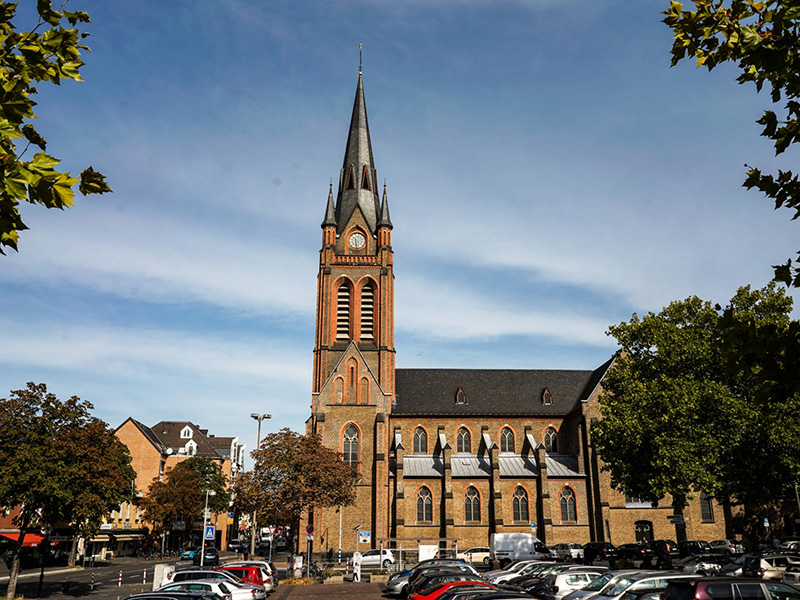17. Projekte Tour: St. Josef Kirche
HISTORISCHE INFORMATIONEN ZUR ST. JOSEF KIRCHE
Auf dieser Seite erhalten Sie weiterführende Informationen zur St. Josef Kirche vom Denkmal- und Geschichtsverein Bonn-Rechtsrheinisch e.V.
St. Josef Kirche
Der Stadtteil Beuel, der dem heutigen Bonner Stadtbezirk seinen Namen gab, besitzt erst seit knapp 140 Jahren ein Gotteshaus. Bis dahin gehörte Beuel, das bereits 1139 urkundlich genannt wird, pfarrlich zu Vilich, zur Pfarrkirche St. Paul und, nachdem diese 1765 eingestürzt war, zur Stifts- und Pfarrkirche St. Peter. Der weite Kirchweg stärkte den Wunsch nach einem eigenen Gotteshaus im wachsenden Beuel.
1875 erwarb ein Mitglied des St. Josefs-Bauverein das heutige, hochwassersichere Kirchengrundstück. Der Baubeginn verzögerte sich dann sowohl wegen der gespannten Situation zwischen Kirche und Staat während des Kulturkampfes, als auch wegen der Baukonzeption. Schließlich wurden die Pläne des damals in Rom studierenden Kaplans Joseph Prill, eines gebürtigen Beuelers, genehmigt, und am 15.08.1880 konnte der Grundstein zum ersten Bauabschnitt gelegt werden. Bereits zwei Jahre später fand der erste Gottesdienst in der neuen Kirche statt. Mit dem zweiten Abschnitt wurde der dreischiffige Kirchenbau vollendet. 1904 schließlich erfolgte die feierliche Konsekration der Pfarrkirche St. Josef.
1981 erhielt die Kirche die neue große Orgel (3 Manuale, Pedal, 61 Register). Sie wurde erbaut durch die Werkstatt der Firma Oberlinger, Windesheim, Disposition und Sachberatung Hans-Peter Reiners. Heute kann sie vom zentralen Spieltisch im Kirchenschiff zusammen mit der Chororgel angespielt werden. Regelmäßig konzertieren Spitzenorganisten in St. Josef.
Orgelanlage
St. Josef verfügt über eine zweiteilige Orgelanlage, bestehend aus Hauptorgel und Chororgel/Fernwerk.
Die große Orgel wurde 1981 von der Orgelbaufirma Oberlinger aus Windesheim erbaut. Das Instrument wurde im französisch-romantischen Stil disponiert; Vorbilder waren die Orgeln der Kathedrale Notre-Dame und der Kirche Saint-Sulpice in Paris. Das Instrument hat heute 61 Register auf drei Manualwerken und Pedal. Grand-Orgue und Récit sind mit Barkermaschinen ausgestattet.
Chororgel
2014 erbaute der Orgelbauer Thomas B. Gaida (Saarbrücken) hinter dem Hochaltar eine Chororgel mit der Funktion eines Fernwerkes mit 9 Registern in einem Schwellkasten. Das Instrument lässt sich – zusammen mit der Hauptorgel – von einem mobilen Spieltisch im Chorraum ansteuern. Dieser neue Spieltisch beinhaltet auch die Möglichkeit, das Klangspektrum der Pfeifenorgeln mittels eines Synthesizers um elektronische Klänge zu erweitern.
Glocken
Im Turm von St. Josef hängt ein siebenstimmiges Bronzegeläut (mittelschwere Rippe). Die Glocken 3 und 5 wurden 1960 von der Glockengießerei Mabilon aus Saarburg gegossen, die restlichen Glocken wurden 1961 von der Glockengießerei Friedrich Wilhelm Schilling (Heidelberg) gegossen.
Quelle: Seelsorgebereich an Rhein und Sieg, Wikipedia
